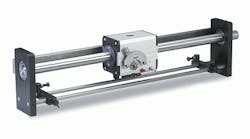Thanks to advances in sensors, motors, and machine technology in general, packaging designers have more speed, accuracy, and automation options at their disposal than ever before. This has helped designers meet demands for increasingly more complex packaging applications, especially when it comes to linear motion.
Numerous reliable, time-proven machines are available to meet practically every linear-motion need, including ball screws, pneumatics, hydraulics, and timing belts, to name a few. After choosing one of these methods, engineers then must choose from an even larger selection of support components—sensors, motors, switches, and so forth—to control the linear motion.
High-end packaging machines incorporate the electronics and controls necessary to provide the linear motion that’s required. This means the investment in linear motion for packaging equipment can be significant. For many operations, however, the investment is justified and necessary. Irregularly shaped boxes, for example, have become commonplace. Flap detection used in gluing a container together requires the integration of sensors and robotics. Batch-control processes, precision labeling, and other high-accuracy packaging procedures also rely on components capable of fine resolution and precise repeatability.
Similarly, selecting a precision ball screw to move a perforating tool across a sheet of printed corrugate might be appropriate if the perforating tool needs to be indexed along the line of travel as opposed to making one continuous cut. Using a precision ball screw means the designer needs to include clutches and gears to stop and reverse the tool, and a bidirectional motor. If the corrugate being cut is fibrous and produces a lot of debris, a shaft bellows or other device needs to be added to protect the screw threads and prevent clogs and jams.
For linear movement of plastic bags under a sealing tool, perhaps a simple conveyor is adequate. However, what if the linear movement needs to stop-and-start or reverse or speed up? If so, a timing belt drive might be more suitable for moving the conveyor.
To tell the timing belt drive how fast to go, which way to go, when to stop, and when to go backward or forward, the control system may require servo/stepping motors, switches, encoders, sensors, or PLCs. Likewise, hydraulic drives also usually require complicated mechanics and electronics as well as multi-speed, direct braked reversible motors, pumps, and solenoids.
How an engineer solves an application’s linear-motion challenge dictates cost and complexity at the design stage, and determines the investments needed in operating, training, and maintenance for the end user. The necessity of complex controls is normal and generally an accepted part of the design. And the rapid rate of new product development has helped keep the costs of linear-motion components in a competitive, relatively affordable range.
Still, when designing machines to perform complex packaging applications, costs can quickly add up and necessitate that end-user budgets accommodate training operators and maintenance personnel. That’s the overriding reason engineers should use their ingenuity to use lower-cost, simpler devices, such as rolling-ring drives, to solve some of their linear-motion problems in packaging (see "Keeping It Simple with Rolling-Ring Drives").
Bob Eisele is Technical Marketing Rep at Amacoil Inc.

